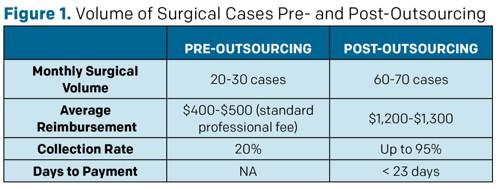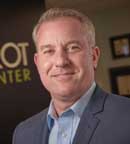The transition to office-based surgery (OBS) represents one of the most significant shifts in contemporary ophthalmology. While the promise of greater control and efficiency draws many surgeons to OBS, implementation often proves more challenging than anticipated. My journey of establishing OBS at Carrot Eye Center in Mesa, Arizona, serves as both a cautionary tale and success story—demonstrating how the right partnership can transform a struggling OBS facility into a thriving surgical center.
Our Vision and Initial Challenges
When my partner and I first considered expanding our surgical capabilities, we initially planned to build a traditional ambulatory surgical center (ASC). However, substantial upfront costs gave us pause. Drawing on my ASC experience, I felt confident we could manage an OBS buildout independently.
We completed our center in late 2019, but COVID-19 struck months later, forcing temporary closure. When we reopened, our snowbird population stayed away due to pandemic concerns. However, even as volumes recovered, we faced a fundamental problem: billing and collections were a disaster.
Despite our clinical expertise and compliance-focused staff, we discovered that managing OBS business operations presented unexpected challenges. OBS reimbursement is not standardized and entails a level of complexity that is difficult for a practice to manage on its own. Insurance companies weren’t willing to contract with our OBS facility, leaving us collecting from only 20% of surgical patients.
One major payor representing 40% of our patients wouldn’t pay professional fees unless surgery occurred in their approved centers. We attempted a split model but remained unprofitable. After years of struggle, we seriously contemplated closure
KEY TAKEAWAYS:
1. Clinical expertise alone isn’t enough for OBS success
2. Strategic partnerships are crucial for profitability and growth
3. Early expert involvement prevents costly mistakes
The Turning Point
Facing potential closure, I reached out to iOR Partners, a consulting company dedicated to ophthalmic OBS, in hopes they could transform our revenue cycle. In October 2024, we partnered with them for comprehensive OBS management, particularly billing and collections. However, their support extended well beyond that. The transformation was immediate and dramatic:
- Billing Excellence: The most critical change was our billing approach. With iOR navigating the intricacies of OBS billing, we immediately brought every patient to our center and began collecting consistent reimbursements for all OBS procedures. Not only are we receiving appropriate insurance reimbursement, we are also saving nearly $7,000 per year on billing software.
- Operational Efficiency: Having an external partner allows for consistent oversight of the OBS suite, taking the burden off our staff. We receive insights on performance, efficiency, and opportunities, ensuring our overall success. For example, their recommendation and guidance in bringing YAGS into the OBS significantly increased our volume. In addition, they have saved the practice money in unexpected ways. We are saving $10,000 annually in charting software by using their customized digital medical record system.
- Compliance Support: Our practice is unique in having compliance expertise in-house. Most practices do not have this and will need an accreditation nurse or outside consultant. iOR complements our compliance efforts by assisting with accrediting body correspondence, QA/PI initiatives, and improvement studies.
Remarkable Results
Our monthly surgical volume more than doubled. We now maintain a 95% collection rate on insurance billing and 86.76% on out-of-network cases, comparable to ASC collection rates. Payment collection averages less than 23 days across all billing types (Figure 1).

Also, we’re now confidently performing procedures we previously avoided, including blepharoplasty, ptosis repairs, and glaucoma surgeries. Incorporating YAG lasers into our OBS suite doubled our YAG revenue (Figure 2).

Lessons Learned
Along with these astounding results came some hard-won wisdom about establishing OBS in a practice:
- Don’t underestimate complexity: Clinical expertise doesn’t automatically translate to OBS business success. Billing and operational challenges are significant.
- Partnership matters: The right partnership provides expertise that would take years to develop internally, if it developed at all.
- Early intervention is crucial: Partner with an expert firm from the beginning. Leverage their expertise to become profitable quickly while delivering unparalleled patient experiences.
We operated independently for 5 years before partnering with iOR. The anxiety, financial losses, and near- closure could have been avoided entirely. Don’t struggle through the learning curve—the financial and emotional costs are too high.
The Evolving Landscape
With an always changing landscape, industry expertise can help to identify trends and stay ahead of the curve. In the United States, more than 4 million cataract surgeries are performed annually, with volume expected to grow by 3-4% each year, reaching 6 million by 2030.1 Furthermore, refractive procedures are expected to increase, as half the population will be myopic by 2050.2 Simultaneously, many ASCs are deprioritizing ophthalmic procedures for more lucrative orthopedic cases, creating critical supply-demand imbalance.
Vertical eyecare integration is necessary to manage patient volume in the future. In fact, it is already happening. Large optometric provider networks are integrating surgical capabilities into their offerings, setting the stage for industry-wide transformation. The shift from ASCs to OBS has made it possible for optometrists to provide surgical care with a hired or contracted ophthalmologist. iOR created a model that enables fair and balanced partnerships between optometrists and ophthalmologists, benefitting both patients and providers.
The transformation at Carrot Eye Center demonstrates that, with the right partnership, OBS delivers on its promise of surgeon autonomy, improved patient care, and greater efficiency. The question isn’t whether OBS works—it’s whether you’ll partner with experts who ensure success from day one. OM
References
1. Ianchulev T, Litoff D, Ellinger D, Stiverson K, Packer M. Office-based cataract surgery: population health outcomes study of more than 21,000 cases in the United States. Ophthalmology. 2016;123(4):723-728. doi:10.1016/j.ophtha.2015.12.020
2. Nouraeinejad A. More than fifty percent of the world population will be myopic by 2050. Beyoglu Eye J. 2021;6(4):255-256. Published 2021 Dec 17. doi:10.14744/bej.2021.27146









